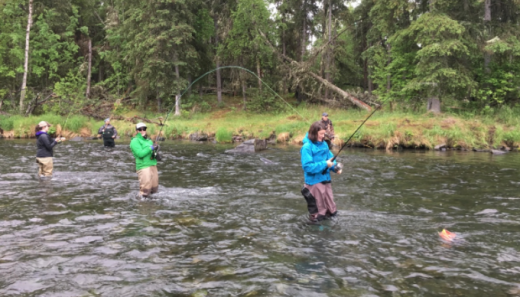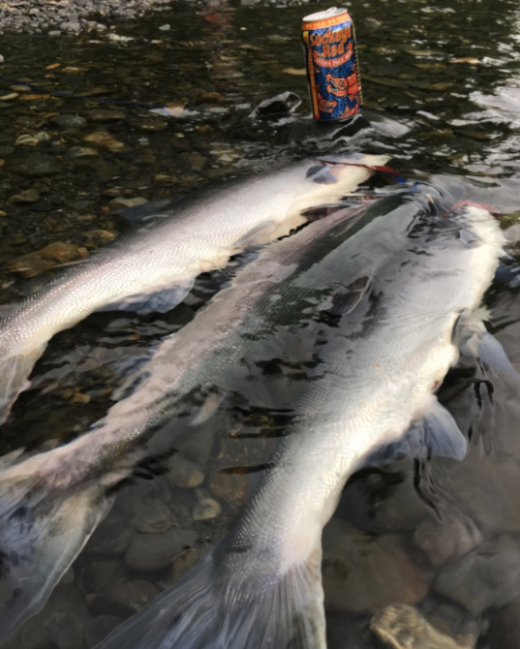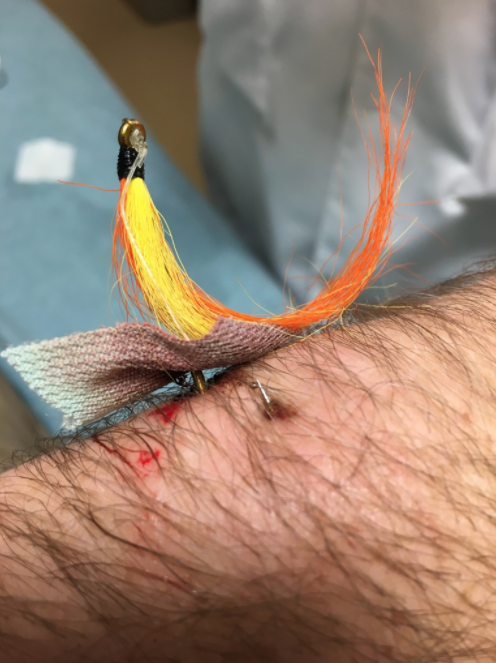by Eric Booton
The midnight sun came and went. We are so accustomed to the unending daylight that we neglected to pack headlamps. We were already run out a fishing hole earlier in the evening by black bear and passing anglers were warning us of a momma brown bear with cubs. It wasn’t the most ideal situation. Especially for my wife who was packing 30 pounds of freshly filleted salmon on her back.
Close to an hour of field operations have proven futile. I can feel the size 2 streamer hook in my arm as I navigate the slippery rocks and logs on my way back to the car. Every movement or flexed muscle is an awkward reminder of its unwanted presence.
I was well on the way to filling my stringer with my limit of six sockeye salmon when a particularly savvy salmonid that was on the end of my line spat the hook directly into my forearm. Thankfully “it’s just a mere flesh wound” (flash back to Monty Python and the Holy Grail).

Well, it is called combat fishing, so I guess a little blood is to be expected. This routine suicide run for salmon was becoming more suicidal than most. We consciously made the two-hour trip from Anchorage to line up, shoulder to shoulder, with the rest of the salmon anglers. It’s a technique known as flossing, it is not glorious, and I’m not going to try and tell you otherwise. But it can be productive. Flossing is a technique involving a big hook (with a large, unpinched barb) and a cannonball’s worth of weight, strategically moved through a school of salmon with hopes that the line will wind up in one’s mouth and the hook will soon follow.

I know catching and killing a fish is a foreign concept to many of you trout bums, but here in Alaska it is a practice that we are fortunate enough to be able to exercise in many areas of our state. The story of salmon throughout North America is an overwhelmingly sad one. Urbanization, habitat degradation, industrialization etc., have devastated and endangered salmon runs throughout the East Coast and much of the West Coast. Alaska stands strong as North America’s salmon powerhouse. Strong enough to entice many of us trout bums to dabble in a bit of catch and kill on the side to fill the freezer and please the wife (and big fish tug hard, which is a nice plus).
This isn’t my first rodeo removing a hook from myself during sockeye season. I’d like to say I am done with this fishery and forever going to dedicate my time to trout and barbless hooks. But you’ll see me out there next year, prepared with kevlar sleeves and a welder’s mask. It has happened. The fish have learned to fight back.
Pro tip: take the time to study up on field techniques for removing hooks from skin with the boys from Cross Current TV… or stick to barbless hooks.
Eric Booton is the sportsmen’s outreach coordinator for TU’s Alaska Program. He lives and works in Anchorage.



